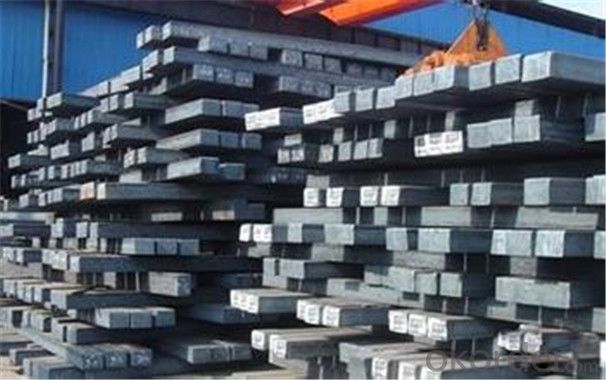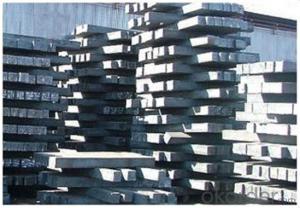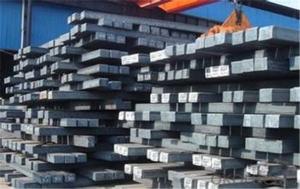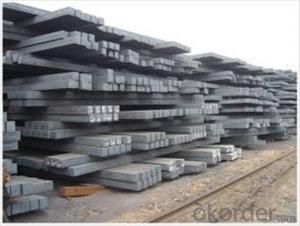Square Steel Billet Hot Sale Q275/5SP in China
- Loading Port:
- Tianjin
- Payment Terms:
- TT OR LC
- Min Order Qty:
- 500 m.t.
- Supply Capability:
- 45555555 m.t./month
OKorder Service Pledge
OKorder Financial Service
You Might Also Like
Item specifice
Description of steel billet:
Our company is recognized by ISO9001:2008
1. hot rolled wire rod
2. material: Q195-235
Festures of steel billet:
1. Drawn wire specialist, your wire rod solution
2. ISO9001 Certified Mill &SGS
3. Feature: machinability, high hardness, toughness, corrosion resistant
Specifications of steel billet:
Name: | steel billets |
LENGTH: | 6 meter to 12 meter (+ 50mm) |
Size: | 100*100, 120*120, 150*150, 200*200 |
Grade: | 3SP,5SP,Q235,20MnSi. |
Shape: | Square, Round |
Technique: | Hot-Rolled |
Standard: | ASTM/GB |
BENDING | No more than 5mm in 1 meter |
ANGULAR TWIST | No more than 1 degree per meter and not more than 6 degree over 12 meter length. |
Images of steel billet:

FAQ:
1. What is your package?
Packing situation: standard seaworthy packing or as customer required.
2. How long is the lead time?
Delivery time: 45 days after order confirmed.
3. What payment term do you accept?
Payment: T/T or L/C at sight.
- Q:How is the inclusion content of steel wire rod determined?
- The determination of inclusion content in steel wire rods involves various methods and techniques. One commonly used approach is the utilization of microscopic analysis, wherein a wire rod sample is examined under a microscope to identify and quantify the inclusions present. To prepare the sample, a small section of the wire rod is typically cut and affixed onto a microscope slide, allowing for a clear and detailed view of the inclusions. Subsequently, the sample is polished and etched to enhance the visibility of the inclusions. Under the microscope, the inclusions can be categorized based on their size, shape, and composition. They can range from tiny particles to larger clusters and can be identified as oxides, sulfides, or other impurities. Quantification of the inclusion content involves counting the number of inclusions within a specific area or volume of the sample. This can be accomplished either manually by individually counting each inclusion or by utilizing automated image analysis software capable of detecting and tallying the inclusions. Besides microscopic analysis, other techniques such as scanning electron microscopy (SEM) and energy-dispersive X-ray spectroscopy (EDS) can be employed to further analyze the inclusions and ascertain their elemental composition. The inclusion content of steel wire rods is a critical quality parameter, as excessive inclusions can detrimentally impact the mechanical properties and overall performance of the final product. Hence, ensuring the accuracy of inclusion content determination is vital for guaranteeing the quality and reliability of the steel wire rods.
- Q:What are the common production processes for darmstadtium-coated steel wire rod?
- The common production processes for darmstadtium-coated steel wire rod involve several steps. First, the steel wire rod is thoroughly cleaned and pre-treated to remove any impurities or contaminants. Then, a layer of darmstadtium is deposited onto the surface of the wire rod using a specialized coating technique such as electroplating or physical vapor deposition. After the darmstadtium coating is applied, the wire rod undergoes a curing or annealing process to ensure the coating adheres properly and has the desired properties. Finally, the coated wire rod is inspected for quality control and may undergo further processing or packaging before being sent for distribution or use in various applications.
- Q:What are the different types of steel wire rod finishes for improved corrosion resistance?
- There are several types of steel wire rod finishes that can enhance corrosion resistance, including galvanized, stainless steel, and zinc-coated finishes. Galvanized finishes involve applying a layer of zinc to the surface of the wire rod, providing a protective barrier against rust and corrosion. Stainless steel finishes are highly resistant to corrosion due to their chromium content, which forms a passive layer on the surface. Zinc-coated finishes, also known as zinc electroplating, involve applying a thin layer of zinc onto the wire rod, providing excellent corrosion resistance.
- Q:What are the common welding techniques used for steel wire rod?
- The common welding techniques used for steel wire rod include gas metal arc welding (GMAW), shielded metal arc welding (SMAW), and resistance welding.
- Q:What are the common surface defects in steel wire rod?
- Some common surface defects in steel wire rods include scale, surface cracks, pits, scratches, and rust.
- Q:How does the tensile strength of steel wire rod vary with different heat treatment processes?
- The tensile strength of steel wire rod can vary significantly depending on the heat treatment process applied. Heat treatment processes such as annealing, normalizing, quenching, and tempering can have a profound effect on the tensile strength of steel wire rod. Annealing is a heat treatment process that involves heating the steel wire rod to a specific temperature and then cooling it slowly. This process helps to reduce internal stresses and improve the ductility of the wire rod. As a result, the tensile strength of the wire rod decreases, but its elongation and overall toughness increase. On the other hand, normalizing is a heat treatment process that involves heating the steel wire rod to a higher temperature than annealing, followed by cooling it in still air. This process refines the grain structure of the wire rod, enhancing its strength and hardness. The tensile strength of the wire rod increases, but its ductility and toughness may decrease slightly. Quenching is a rapid cooling process that involves immersing the steel wire rod in a quenching medium, such as oil or water, after heating it to a high temperature. This process results in the formation of a strong and hard structure, known as martensite, in the wire rod. Consequently, the tensile strength of the wire rod significantly increases, but its ductility decreases substantially. Lastly, tempering is a heat treatment process that involves reheating the quenched wire rod to a lower temperature and then cooling it slowly. This process helps to relieve internal stresses and reduce the brittleness caused by quenching. As a result, the tensile strength of the wire rod decreases slightly, but its ductility and toughness improve. In summary, different heat treatment processes can have varying effects on the tensile strength of steel wire rod. Annealing decreases the tensile strength but improves the ductility, normalizing increases the tensile strength while slightly reducing ductility, quenching significantly increases the tensile strength but decreases ductility, and tempering slightly reduces the tensile strength while improving ductility. Therefore, the choice of heat treatment process should be carefully considered based on the desired properties of the steel wire rod.
- Q:How is steel wire rod used in the manufacturing of wire nets?
- Wire nets, essential in the production of wire nets due to their strength, durability, and flexibility, are commonly used in industries such as construction, agriculture, mining, and transportation for fencing, mesh screens, and reinforcement. To manufacture wire nets, steel wire rods undergo a series of processes. Initially, the wire rods undergo meticulous quality inspection and conformity checks. Next, they go through the drawing process, where they are pulled through dies to reduce their diameter and increase their length. This process enhances the wire's tensile strength and flexibility, making it ideal for use in wire nets. Following the drawing process, the wire undergoes annealing, a crucial heat treatment that relieves internal stresses and improves its ductility. This ensures that the wire can be woven or welded into various net configurations. Once the wire is prepared, it is used to create wire meshes or nets through weaving or welding methods. In the weaving process, the wire strands are interwoven in a crisscross pattern to form a grid-like structure. Different weaving patterns, such as plain weave, twill weave, or Dutch weave, can be chosen based on the desired strength and opening size of the wire net. Alternatively, the wire can be welded at intersecting points to form a welded wire mesh. This process involves applying heat and pressure to join the wires, resulting in a sturdy and uniform net structure. Welded wire mesh is commonly used in applications requiring higher strength and stability. Once manufactured, wire nets can be used for various purposes, including perimeter fencing, area partitioning, and industrial protection barriers. The strength and durability of steel wire rods ensure that wire nets can withstand harsh environmental conditions, resist corrosion, and provide reliable performance over an extended period. In conclusion, steel wire rods are crucial in the manufacturing of wire nets, thanks to their strength, durability, and flexibility. Wire nets have diverse applications in different industries, providing solutions for fencing, mesh screens, and reinforcement requirements.
- Q:How are steel wire rods used in the manufacturing of surgical instruments?
- Steel wire rods are commonly used in the manufacturing of surgical instruments due to their high strength and durability. These rods are first cut into desired lengths and then shaped into various instrument components such as handles, shafts, or cutting edges. The steel wire rods serve as the base material, providing the necessary strength and integrity required for surgical instruments to withstand the rigorous demands of medical procedures.
- Q:Can steel wire rod be galvanized?
- Yes, steel wire rod can be galvanized. Galvanizing is a process in which a protective zinc coating is applied to steel to prevent it from rusting.
- Q:How is steel wire rod used in the manufacturing of wire for cable trays?
- Steel wire rod is used in the manufacturing of wire for cable trays as it serves as the primary raw material. The wire rod is first processed through various stages, including drawing and annealing, to achieve the desired diameter and mechanical properties. Once transformed into wire, it is then further processed, such as being cut to length, shaped, and welded to form the intricate mesh structure of the cable tray. The steel wire rod provides the necessary strength, durability, and conductivity required for cable trays to securely hold and organize electrical cables in various installations.
1. Manufacturer Overview |
|
|---|---|
| Location | |
| Year Established | |
| Annual Output Value | |
| Main Markets | |
| Company Certifications | |
2. Manufacturer Certificates |
|
|---|---|
| a) Certification Name | |
| Range | |
| Reference | |
| Validity Period | |
3. Manufacturer Capability |
|
|---|---|
| a)Trade Capacity | |
| Nearest Port | |
| Export Percentage | |
| No.of Employees in Trade Department | |
| Language Spoken: | |
| b)Factory Information | |
| Factory Size: | |
| No. of Production Lines | |
| Contract Manufacturing | |
| Product Price Range | |
Send your message to us
Square Steel Billet Hot Sale Q275/5SP in China
- Loading Port:
- Tianjin
- Payment Terms:
- TT OR LC
- Min Order Qty:
- 500 m.t.
- Supply Capability:
- 45555555 m.t./month
OKorder Service Pledge
OKorder Financial Service
Similar products
New products
Hot products
Related keywords




























